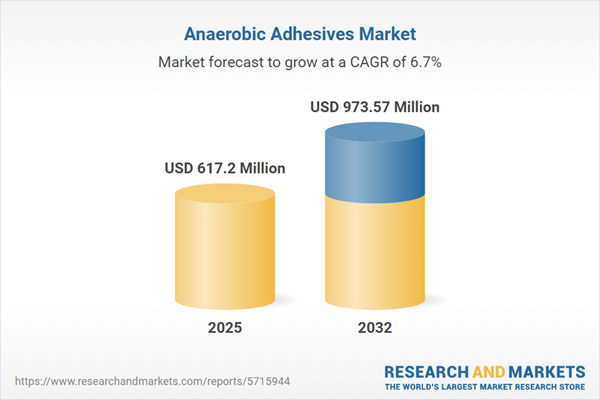Speak directly to the analyst to clarify any post sales queries you may have.
Anaerobic adhesives are increasingly vital to industrial manufacturing and maintenance, delivering reliable, cost-efficient bonding and sealing solutions. This report equips senior executives with the critical insights required to harness the full value of market dynamics and strategic trends in the anaerobic adhesives sector.
Market Snapshot: Anaerobic Adhesives Market Size and Outlook
The global anaerobic adhesives market grew from USD 578.59 million in 2024 to USD 617.20 million in 2025, and is forecast to expand at a CAGR of 6.72%, reaching USD 973.57 million by 2032. This sustained growth reflects strong demand across sectors prioritizing operational efficiency, joint integrity, and sustainability-driven upgrades in manufacturing and maintenance protocols.
Scope & Segmentation
- Product Types: Gasket maker, instant adhesives, metal bonding adhesives, retaining compounds, structural adhesives, threadlocker (high strength, medium strength, low strength)
- Applications: Aerospace, automotive (body assembly, chassis and suspension, electrical systems, engine components), electronics, healthcare, industrial maintenance
- End Use Industries: Aftermarket repair, automotive OEMs, construction, electronics manufacturing, machinery manufacturing
- Form Factors: Liquid, film, paste, tape
- Sales Channels: Direct sales, distributors, e-commerce platforms
- Geographic Coverage: Americas (North America, Latin America), Europe, Middle East & Africa (sub-segments by country), Asia-Pacific (key economies across the region)
- Companies Profiled: Henkel AG & Co. KGaA, 3M Company, H.B. Fuller Company, Arkema S.A., Sika AG, RPM International Inc., Parker-Hannifin Corporation, Permabond LLC, DELO Industrial Adhesives GmbH & Co. KG
Key Takeaways for Senior Decision-Makers
- Anaerobic adhesives offer rapid curing in oxygen-deprived environments, enabling precise gap filling and long-term reliability in critical bond areas.
- Adhesive formulations serve diverse operational needs, from sealing fluid systems and reinforcing lightweight composite assemblies to safeguarding electronic micro-connections and healthcare devices.
- Regional regulatory differences, especially across Europe, Middle East & Africa, require manufacturers to prioritize compliant, low-emission chemistry innovations and localized production strategies.
- Technological integration with Industry 4.0 systems, such as automated dispensing and cure monitoring, supports lean manufacturing and enhances bond consistency.
- Collaborations between adhesive manufacturers and OEMs are driving co-developed solutions tailored to emerging materials and demanding operating conditions.
- Segment variations, including form (liquid, paste, film, tape) and channel (direct, distributor, e-commerce), allow for tailored solutions addressing unique volume, technical, and service requirements.
Tariff Impact: Navigating U.S. Trade Policy Shifts
The 2025 United States tariff regime has increased complexity for global anaerobic adhesives supply chains. Additional levies on chemical intermediates have driven up procurement costs, prompting shifts in sourcing strategies. Many manufacturers have expedited local production or diversified their supplier base to reduce exposure to trade disruptions. This has led to new industry partnerships, especially within Asia-Pacific, but may also generate longer lead times and more fragmented qualification processes. Proactive contract renegotiation, inventory risk management, and scenario analysis are now critical supply chain levers.
Methodology & Data Sources
This analysis integrates in-depth interviews with value chain stakeholders, secondary reviews of industry literature, patent trends, and regulatory filings. Regular peer reviews and cross-verification with distributor and manufacturer survey data assure accuracy and relevance across technology adoption, compliance, and procurement landscapes.
Why This Report Matters
- Gain granular insight to optimize adhesive selection based on fast-evolving form factors and regional compliance requirements across major economies.
- Identify technology, sourcing, and partnership opportunities by understanding market fragmentation and innovation pipelines within the anaerobic adhesives segment.
- Enhance operational resilience by benchmarking supply chain and tariff navigation strategies now reshaping industry best practices for procurement leaders and product managers.
Conclusion
The anaerobic adhesives market is evolving through technology integration, customer-centric R&D, and strategic resiliency planning. Forward-thinking stakeholders leveraging these insights will be best positioned to support future-ready manufacturing and maintenance operations.
Additional Product Information:
- Purchase of this report includes 1 year online access with quarterly updates.
- This report can be updated on request. Please contact our Customer Experience team using the Ask a Question widget on our website.
Table of Contents
3. Executive Summary
4. Market Overview
7. Cumulative Impact of Artificial Intelligence 2025
Companies Mentioned
The companies profiled in this Anaerobic Adhesives market report include:- Henkel AG & Co. KGaA
- 3M Company
- H.B. Fuller Company
- Arkema S.A.
- Sika AG
- RPM International Inc.
- Parker-Hannifin Corporation
- Permabond LLC
- DELO Industrial Adhesives GmbH & Co. KG
Table Information
| Report Attribute | Details |
|---|---|
| No. of Pages | 191 |
| Published | October 2025 |
| Forecast Period | 2025 - 2032 |
| Estimated Market Value ( USD | $ 617.2 Million |
| Forecasted Market Value ( USD | $ 973.57 Million |
| Compound Annual Growth Rate | 6.7% |
| Regions Covered | Global |
| No. of Companies Mentioned | 10 |









